 BUY IT AT AMAZON: CLICK HERE!
BUY IT AT AMAZON: CLICK HERE!
STUDIO: Buena Vista Home Entertainment
MSRP: $49.99 RATED: TV Y7
RUNNING TIME: 569 Minutes
SPECIAL FEATURES:
• Episode introductions by Stan Lee
• "Stan Lee’s Soapbox"
I’m the
sort of guy who is affected by honest enthusiasm; I find it contagious. That’s
why I’ve always loved Stan Lee. He unabashedly loves his creations, and, when
he talks about them in his quasi-archaic grammar, I can’t help but try and love
them, too. (Except, of course, when I’m being an objective and impartial
reviewing entity.) Each episode of this 1994-95 animated series of the Fantastic
Four begins with the option of viewing a brief, episode-specific, and
ebullient introduction by Lee.
Unfortunately,
as marketing ploys usually do, these introductions offer more hype than the
show has content. It’s a fun show, if you’re not looking for more than to
revisit, if not the actual stories, then the experience you felt as a child
first discovering these comics. If, as an adult, you want only to be
entertained, you’re not likely to find much worth your time, here.
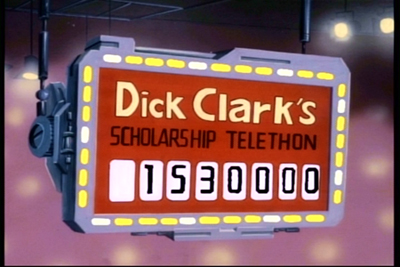
Washington State’s illiteracy census was never meant to be publicized.
The Show
Fantastic Four is a show that casts back to the
earlier days of Lee and Kirby, both for stylistic inspiration and plot
elements. Then come the inevitable modifications to fit the stories into
twenty-two minute chunks. Characterization is jettisoned, as are most of the philosophical
tensions between the four and their enemies, and between themselves.
Each of
the four are initially reduced to the barest caricatures of comic book
counterparts. This is a personal peeve of mine regarding children’s
programming; I believe children can understand characterization more complex
than what Fantastic Four delivers. This version of Ben Grimm likes to hit
things, and doesn’t give a hoot about turning back into his lovable human self.
Reed Richards spouts off technobabble and says, "Of course!" a lot. Susan
Storm is sensitive and overly dependent on Reed. Johnny Storm is a rebel, and
doesn’t like to be told what to do, except in certain situations during which
he’s perfectly fine with being told what to do.
The main
focus is on the adventures, and they are kind of hit-and-miss. In the
twenty-six episodes, covering two seasons, roughly half are aimless fights
between the four and the monster of the week. The structure of these episodes
are roughly identical: a villain somehow attacks the unwitting four, then Reed
bullshits his way through to a solution, while Ben repeats variations on the
phrase, "Once more in English." There are more than a couple
instances of pure camp sneaking into the scripts, and it’s camp done poorly, with no earnestness behind the flat humor.

Some guys just don’t know how to treat a girl who isn’t wearing leather.
There is
a slight division in quality between the first and second season. A different
writing and directing team took over for the second season, and a different
theme song is (thankfully) put in place. More on the atrocious first season
theme below. The stories pick up a bit in entertainment value, taking some of the villains
from the first season and expanding on them.
These episodes
rate a bit higher on the fun meter. A number of familiar faces show up, such as
the Puppet Master, Galactus, the Silver Surfer, and Super Skrull. These
episodes succeed primarily because of the villains. We’ve already established
that the four themselves have no depth of character, but often quite a bit more
is invested in the baddies. Doom, for example, gets an extensive flashback
origin story. Galatcus is built up well, even if his various preparations to
devour the Earth are too consumed by histrionics. The Skrull come across as
easily-duped, and witless when it comes to invasion preparation, but their
episodes are among the best; they actually demonstrate a scientific competition
between Reed and the Skrull, a challenge to Reed’s near-magical intellect.
Some of
the larger stories require multi-part episodes. This would be a good thing —
the one-shots often feel cramped in their twenty-odd minutes — except that
each subsequent episode in an arc wastes inordinate amounts of running time
recapping the goings on of the previous episode. ‘Ware the over-exposition; an
odd choice in a show that’s driven entirely by plot.
The
artwork, especially in season one, carries an impression of being hurried
through production, perhaps by one thousand monkeys with one thousand 0.2 ink
pens. Character bodies change drastically depending on perspective;
interstitial frames are sometimes dropped, resulting in chunky motion; transitions
(such as Johnny turning on his flame or Ben becoming the Thing) are done using
fading between just three frames: a base state, an intermediate state, and the
full transformation. This aspect of the visuals reeks of cheap or rushed labor,
but it’s just the sort of animation that a lot of us grew up with. It’s
forgivable when the story is engaging, but distracting when the story is
boring.
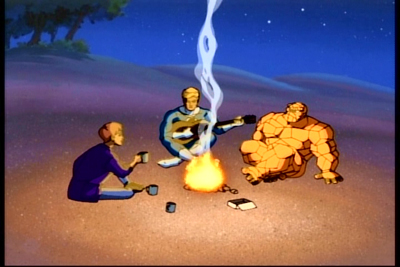
Even Ben was transfixed by Johnny’s rendition of "The One True Kevin."
This is
weightless stuff. It’s a better show than the other attempts to animate
Marvel’s first family (at least this one retains the Human Torch instead of
replacing him with a robot), but it’s got no real grab to it, no hook for
anybody who doesn’t already love the characters. Even if you do love the
characters, you’re not going to find much depth to sink into and enjoy — not
unless you’re the type to winnow commentary on subversive racism from the Ninja
Turtles oeuvre. The second scene improves on the characters of the
protagonists, but it’s a lackluster attempt, and they never grow their extra
dimensions.
It’s hard
to not look fondly at Stan Lee, despite his overwhelming enthusiasm for this
unworthy material. He created four enduring heroes, and countless memorable
villains for them to fight. All that has come through of those characters in
this series is their likenesses. I remember reading these comics as a child,
being thrilled by their basic abilities and my sketchy understanding of their characters; I was similarly excited, though
more subdued (I stopped yelling "Flame on!" right around tenth
grade,) when I discovered these characters had coherent histories, arcs, things
that informed their adventures and tied them up into a timeline that felt real.
I’m not
suggesting that Saturday morning cartoons ought all to have the depth of Batman:
The Animated Series (I’d sure start getting up earlier on Saturday if
they did,) but this Fantastic Four series smacks of a lack of effort and, though
occasionally diverting, its negative qualities easily outweigh the good. $49.95 is well beyond what this set is worth.
(As a
handy comparison to the recent movie: Jessica Alba got to do more exploration
of the character of Sue Storm than the Invisible Woman in this series.)
4.2 out of 10
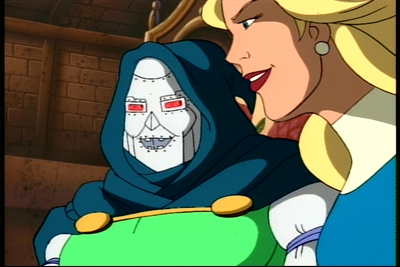
It just means he farted in his armor.
The Look
Presented
in its original television aspect ratio, 1.33:1. The transfer has a few
regrettable errors, particularly with edge enhancement. In an animation such as
this, full of bold strokes, the edges need to look clean, but during motion the
edges often blur or are corrupted by hashing. When it happens, it’s hideous and makes your
eyes water, and definitely lowers the value of the disc in this reviewer’s eyes.
The color
is universally good, well-preserved during transfer. With the four standing
together, we get a bold red, a burnt orange, a deep blue, and whatever Sue
feels like transmitting. There seems to have been an effort to keep a nice
balance onscreen at all time; the visuals are rarely dull.
3.0 out of 10
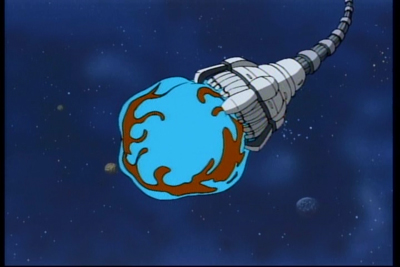
"We’ll take some of the fat from this vibrant and living planet,
and implant it in your lips."
The Noise
The
soundtrack has been remastered in Dolby Digital 5.1 Surround, but, for the life
of me, I can’t figure out why. The rear channels are hardly utilized as
anything more than duplicated front channels. All we get from having this
master is a technically better presentation of the godawful first season theme
song (sample lyrics: "Reed Richards is elastic / Sue can fade from sight /
Johnny’s the human torch / The Thing just loves to fight." Note that Ben’s
the only one dehumanized.) The second season’s theme was purely instrumental.
So,
there’s not much to hear, but you can hear it clearly.
5.5 out of 10
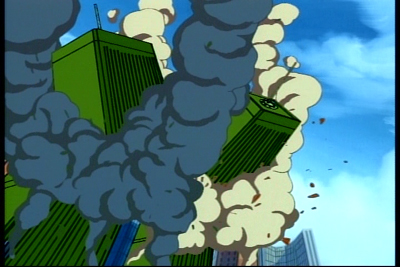
On September 11th, 2001, a group of militant extremist Skrull
attacked the Emerald City.
The Goodies
There is
the abovementioned optional introduction for each episode, each lasting no more
than twenty seconds but filled with enough enthusiasm to match your average
Harry Knowles review.
The only
other feature is a "Stan Lee’s Soapbox", an eight minute monologue
from the man himself about the origins of the Fantastic Four, his working
relationship with Kirby, and the business aspects of early Marvel. This little
feature strikes me as mismatched to the set, because it’s clearly targeted at
adults, children not being much interested in the office interplay between a
writer and an artist. (Or maybe they are? Them writers and artists is complex characters.) The show itself is
clearly targeted at an abstract demographic of children. Maybe this is a case
of throwing something onto the discs so the parents will have something to
watch.
The
parents get the short end of the stick, because there’s nothing else in the way
of special features.
4.0 out of 10
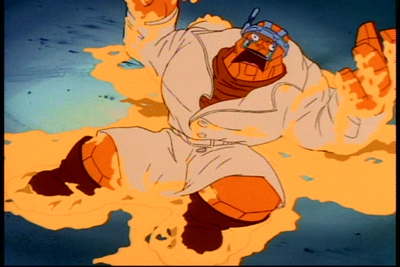
This is for a toothache. He hasn’t even had his prostate exam, yet.
The Artwork
I really
like this artwork. It’s subdued. On the slipcase, the four are backlit in the
top right corner, casting long shadows. The logo and title are done up in a
refraction pattern, but it’s not ostentatious. And, a personal joy for me,
there are no marketing blurbs mucking up the cover. The cover of the interior
case is the same.
There are
four discs, so, naturally, there’s a portrait of one of our heroes per disc. The
four discs fit neatly into a foldout package the size of a standard DVD case,
two discs per page in an ingenious overlap. The only problem with this design
is you can’t reach the second disc on a page without removing the first one.
7.5 out of 10
Overall 4.7 out of 10